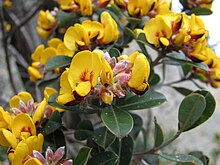Pultenaea
| Pultenaea | |
|---|---|
 |
|
| Pultenaea daphnoides | |
| Scientific classification | |
| Kingdom: | Plantae |
| (unranked): | Angiosperms |
| (unranked): | Eudicots |
| (unranked): | Rosids |
| Order: | Fabales |
| Family: | Fabaceae |
| Subfamily: | Faboideae |
| (unranked): | Mirbelioids |
| Genus: |
Pultenaea Sm. |
| Type species | |
|
Pultunaea stipularis |
|
| Species | |
 |
|
| Range of Pultenaea Sm. | |
Pultenaea is a genus of flowering plants in the family Fabaceae-Faboideae that are native to Australia. They are known commonly as bush peas.
The genus is found in south west Western Australia and the eastern states. It is not considered to be monophyletic with suggestions of splitting it into six separate subgenera, under a larger genus of Pultenaea sensu lato, which would include 19 out of 25 genera included in the former tribe Mirbelieae. The genus underwent explosive starburst radiation, with biogeographical divisions due to the Nullarbor Plain and the winter/summer rainfall boundary. Some species rely on fire regimes for germination, and are an understorey dominant and nitrogen fixer.
The genus was first formally described by botanist James Edward Smith in 1794 in A Specimen of the Botany of New Holland, with Pultunaea stipularis nominated as the type species. The latter was described from a living specimen which was raised in , England from seed obtained from New South Wales in 1792. Smith named the genus in honour of Richard Pulteney, an English surgeon and botanist, who also was the biographer of Linnaeus.
Pultenaea belongs to the Mirbelioid clade of the legume subfamily Faboideae. Pultenaea is paraphyletic with respect to several of the other mirbelioid genera.Molecular phylogenetics supports 7 clades within the current circumscription of Pultenaea:
...
Wikipedia
